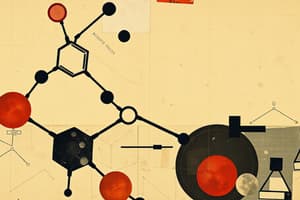Podcast
Questions and Answers
What is the primary reason carbonyl compounds undergo nucleophilic addition reactions?
What is the primary reason carbonyl compounds undergo nucleophilic addition reactions?
- Carbon atoms have higher electronegativity than oxygen atoms.
- Nucleophiles are attracted to negatively charged atoms.
- The presence of acidic groups reduces nucleophilic strength.
- The carbonyl carbon possesses a partial positive charge. (correct)
Which effect allows stabilization of the positive charge in a carbocation?
Which effect allows stabilization of the positive charge in a carbocation?
- The presence of a neighboring functional group.
- Hyperconjugation through adjacent C-H bonds. (correct)
- Delocalization of electrons from pi bonds.
- The inductive effect of nearby electronegative atoms.
How does the inductive effect influence a nucleophile's ability to react with a carbonyl compound?
How does the inductive effect influence a nucleophile's ability to react with a carbonyl compound?
- It enhances the nucleophile's polarization towards the carbonyl carbon.
- It affects the stability of the carbonyl electrophile. (correct)
- It increases the nucleophile's charge density.
- It decreases the overall charge of the nucleophile.
What role does delocalization play in stabilizing carbocations?
What role does delocalization play in stabilizing carbocations?
In a nucleophilic addition mechanism, what is the first step that occurs?
In a nucleophilic addition mechanism, what is the first step that occurs?
What is the primary difference between Markovnikov and Anti-Markovnikov addition in reactions with unsymmetrical alkenes?
What is the primary difference between Markovnikov and Anti-Markovnikov addition in reactions with unsymmetrical alkenes?
Which factor is most associated with stabilizing a positive charge in a carbocation?
Which factor is most associated with stabilizing a positive charge in a carbocation?
What type of stabilization involves the overlap of the carbocation's vacant 2p orbital with neighboring C-H bonds?
What type of stabilization involves the overlap of the carbocation's vacant 2p orbital with neighboring C-H bonds?
Which of the following correctly describes the inductive effect in regard to carbocation stability?
Which of the following correctly describes the inductive effect in regard to carbocation stability?
How does hyperconjugation differ from inductive effects in the context of carbocation stabilization?
How does hyperconjugation differ from inductive effects in the context of carbocation stabilization?
Which product is expected from a reaction of an unsymmetrical alkene with HX under Markovnikov's rule?
Which product is expected from a reaction of an unsymmetrical alkene with HX under Markovnikov's rule?
What characteristic contributes to a carbocation being more stable?
What characteristic contributes to a carbocation being more stable?
Which statement best represents the concept of delocalization in relation to carbocations?
Which statement best represents the concept of delocalization in relation to carbocations?
What characterizes electrophilic addition reactions?
What characterizes electrophilic addition reactions?
Which of the following statements is true regarding Markovnikov’s rule?
Which of the following statements is true regarding Markovnikov’s rule?
Which factor contributes most significantly to the stabilization of a carbocation?
Which factor contributes most significantly to the stabilization of a carbocation?
Which of the following describes hyperconjugation in carbocations?
Which of the following describes hyperconjugation in carbocations?
What effect does an inductive effect have on a carbocation?
What effect does an inductive effect have on a carbocation?
Which statement accurately reflects nucleophilic addition reactions?
Which statement accurately reflects nucleophilic addition reactions?
In which scenario would nucleophilic addition be favored over electrophilic addition?
In which scenario would nucleophilic addition be favored over electrophilic addition?
What is one effect of substituents on the stability of carbocations?
What is one effect of substituents on the stability of carbocations?
Flashcards
Markovnikov's rule
Markovnikov's rule
In the addition of HX to an unsymmetrical alkene, the hydrogen atom adds to the carbon atom with more hydrogen atoms.
Anti-Markovnikov addition
Anti-Markovnikov addition
Addition of HX to an unsymmetrical alkene, where hydrogen adds to the less substituted carbon atom.
Carbocation stability
Carbocation stability
More highly substituted carbocations are more stable than less substituted ones due to alkyl group electron donation.
Inductive effect
Inductive effect
Signup and view all the flashcards
Hyperconjugation
Hyperconjugation
Signup and view all the flashcards
Regioselective product
Regioselective product
Signup and view all the flashcards
Unsymmetrical alkene
Unsymmetrical alkene
Signup and view all the flashcards
Carbocation
Carbocation
Signup and view all the flashcards
Nucleophilic Addition
Nucleophilic Addition
Signup and view all the flashcards
Electrophile
Electrophile
Signup and view all the flashcards
Carbonyl Group
Carbonyl Group
Signup and view all the flashcards
Partial Positive Charge on Carbonyl Carbon
Partial Positive Charge on Carbonyl Carbon
Signup and view all the flashcards
Stabilization of Oxygen's Negative Charge
Stabilization of Oxygen's Negative Charge
Signup and view all the flashcards
Electrophilic Addition
Electrophilic Addition
Signup and view all the flashcards
Regioselective Reaction
Regioselective Reaction
Signup and view all the flashcards
Study Notes
Organic Pharmaceutical Chemistry (PCH 301)
- Course focus: Organic Reactions and Mechanisms
Addition Reactions
- Addition reactions: Chemical reactions where small molecules add to compounds to form adducts.
- Occur in compounds with pi (π) electrons.
- Product contains all elements of the reacting species.
- Types:
- Electrophilic addition: Electrophile accepts electron pair from a double or triple bond, forming a carbocation intermediate, followed by nucleophile attack to form the addition product.
- Nucleophilic addition: Nucleophile attacks the electron-deficient double bond forming an anion intermediate, followed by protonation to form the addition product.
- Carbon-carbon double bond (C=C) and carbon-carbon triple bond (C≡C) are common sites for electrophilic addition.
- Carbon-hetero atom double bonds (such as C=O) and triple bonds (such as C≡N) are sites for nucleophilic addition.
Electrophilic Addition Reactions
- Electrophile: Electron-seeking species.
- Accepts electron pair from the double or triple bond.
- Forms carbocation intermediate.
- Nucleophile attacks the positive species to form the addition product.
General Reaction Mechanisms (Electrophilic Addition)
- Step 1 (Slow): Electrophile attacks the π bond, forming a carbocation intermediate.
- Step 2 (Fast): Nucleophile attacks the carbocation, forming the final product.
General Reaction Mechanisms of Hydrogenation of Alkenes and Alkynes
- Alkene or alkyne + hydrogen (H2) + Metal Catalyst (Pt, Pd or Ni ) gives Alkanes.
- Two new C—H bonds are simultaneously formed from H atoms.
- The catalyst surface attaches the alkene and a hydrogen atom is transferred to the alkene. A second hydrogen atom is transferred to the same face of double bond.
- Hydrogen atoms add to the same face of the double bond (syn addition).
Hydrogenation Reaction Energy Diagram
- A catalyst lowers the activation energy needed to reach the transition state.
Addition to Symmetrical and Unsymmetrical π bonds
- Symmetrical alkenes/alkynes have the same substituents at each end of the bond.
- Unsymmetrical alkenes/alkynes have different substituents at each end of the bond.
Electrophilic Addition to Unsymmetrical Alkenes
- Markovnikov's rule: Addition of unsymmetrical reagents to an unsymmetrical alkene, where the hydrogen adds to the carbon with more hydrogen atoms.
Carbocation Stabilization
- Factors that stabilize carbocation:
- Inductive effects: Alkyl groups donate electrons to the positive center, stabilizing the carbocation.
- Hyperconjugation: Overlap of the vacant 2p orbital of the carbocation with a neighboring C-H σ-bond orbital, stabilization the carbocation.
- Delocalization: Distribution of electron density beyond a fixed place stabilizing the carbocation.
Halogenation of Alkenes and Alkynes
- Addition of halogen (Cl2 or Br2) across the double bond in an alkene to yield a vicinal dihalide.
- Used as a test for unsaturation (π bonds). The red colour of the bromine reagent disappears when an alkene or alkyne is present.
- Halides add to neighboring carbons from opposite faces of the molecule.
- Reaction occurs in the presence of inert and non-nucleophilic solvents (e.g., methylene chloride, chloroform, or carbon tetrachloride).
Hydration of Alkenes and Alkynes
- Addition of water (H2O) to an alkene in the presence of an acid catalyst (H2SO4) forms alcohols.
- Follows Markovnikov's rule.
- Highly regioselective reaction.
Nucleophilic Addition Reactions
- Nucleophile: Electron-rich species.
- Attacks the electron-deficient carbonyl carbon to form anion intermediate.
- Second step is protonation of the anion to form the addition product.
- Oxygen is more electronegative than carbon, causing carbonyl carbons to have partial positive charge and act as electrophiles.
Addition of Organometallic Reagents to Carbony Compounds
- Aldehydes and ketones react with organometallic reagents, such as Grignard reagents, to yield alcohols.
- Grignard reagent reacts with CO2 to give magnesium salts of carboxylic acids, followed by acidification to form the carboxylic acid.
Reaction of Ammonia Derivatives with Carbonyl Compounds
- Primary amines, hydroxylamine, hydrazine, and semicarbazide react with aldehydes and ketones in the presence of an acid catalyst to generate imines or substituted imines.
Studying That Suits You
Use AI to generate personalized quizzes and flashcards to suit your learning preferences.




